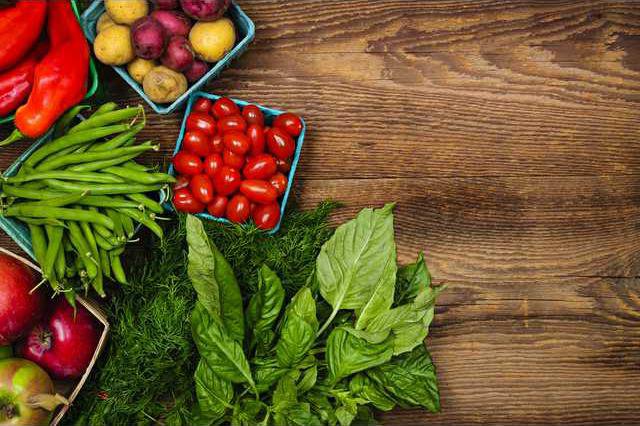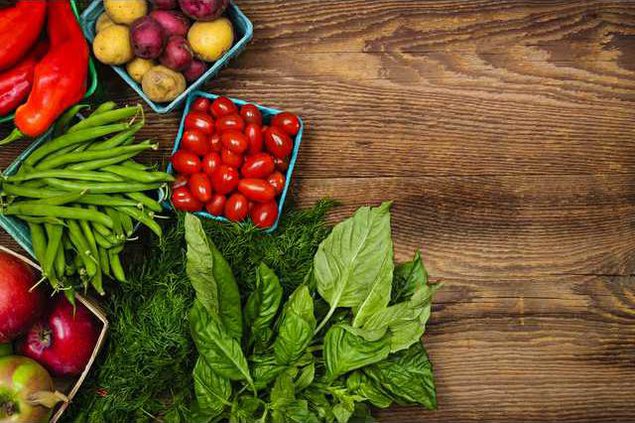Which type of produce is best to eat?
The short answer is any produce.
Really, truly.
The best kinds of produce are the kinds you will eat regularly because you enjoy them and you can afford them.
Most Americans live in a time and place of food abundance. Abundance has given us the luxury of being choosy with our food. This can be a good thing, but it can also lead to unneeded concern about every bite we eat; the thought that each bite needs to contribute nutrient superpowers to help us thrive.
Simply stated, fruits and vegetables are good for your health.
Eat a variety of colors, including white. Youve probably heard to eat deeply colored produce, which is a good recommendation, but can be too exclusive. Potatoes, garlic, onions, cauliflower, mushrooms, ginger, bananas and pears are all white produce providing nutrients, water, fiber and a variety of flavors.
Spinach and kale are darker and more nutrient-dense than iceberg lettuce, but if youre looking for a crisp crunch on your sandwich, dont feel bad about using iceberg lettuce in their place.
Prepare your produce in a variety of ways. This adds culinary variety and interest to your diet. Sometimes a cooked vegetable is more appealing to some than a raw one or budget friendly. In such cases, a cooked, frozen, dried or canned vegetable is an excellent choice.
Cooked produce
Cooking fruits and vegetables sometimes gets a bad wrap from the raw food movement. The raw food movement may influence many to believe that raw is best. While raw is good, sometimes it isnt always best. In some cases cooking produce actually makes some nutrients like the phytochemical lycopene and fat soluble vitamins more bioavailable, meaning the nutrients are easier for your body to access and use in the food.
Microwaving, steaming and stir-frying or sauteing are the best choices to minimize loss of vitamins C and Bs and phenols. Vitamin A and B vitamin folic acid are also affected by cooking. But boiling, roasting, baking and grilling do not affect nutrient values enough to stress about. Lower heat for less time is ideal. As a general rule, aim to leave vegetables a little crunchy or al dente after the cooking process for best nutrient quality.
Canned produce
Canned foods are cooked at high temperatures to kill off potentially harmful microorganisms. Vitamin C is reduced in this process, but may be added back as a preservative in the form of ascorbic acid. Canned food actually retains a high nutrient value. And as an added bonus, can offer cost savings compared to their frozen and fresh counterparts.
If you have high blood pressure and are sensitive to sodium, be sure rinse to canned vegetables to reduce the amount of sodium by nearly half and keep in mind that most sodium in our diets isnt coming from canned goods, but fast foods and luncheon meats. Also, choose fruits canned in light syrup or 100 percent fruit juice to avoid large amounts of added sugar.
Dried fruit
Nutrients in dried fruit are concentrated as water is leaves. Dried fruit can be an excellent source of many nutrients, including potassium and fiber. Its important to note that energy is also concentrated in dried fruits making it higher in calories per volume measure. One cup of raisins is higher in calories than 1 cup of grapes. In appropriate portions sizes, dried fruit is a very healthy choice with lasting value.
Frozen produce
Frozen produce retains much of its nutrient value because it is often flash-frozen quickly after harvest, immediately preserving the food. Often frozen produce is blanched before freezing, or quickly cooked in hot water and then quickly cooled, to stop enzymatic activity in the produce that will naturally affect flavor, nutrients and quality over time. Blanching will affect the nutrients just like cooking, but freezing will preserve them. It is actually not uncommon for frozen produce to be higher in nutrient value than fresh produce that has aged in storage after the harvest.
Though frozen produce can be more expensive, it may be less so in the long run due to reduced food waste. Fruit frozen and kept at low temperatures can store up to one year, and many vegetables up to 18 months.
Fresh produce
Fresh produce is delicious and nutritious. Eat it quickly, store it appropriately, and preserve it if you cant get to it. Over time, harvested produce will incrementally lose B and C vitamins even without cooking.
The quality of fresh vegetables and all produce depend on the location, soil quality, the time its harvested and the amount of time its stored.
The bottom line
All forms of produce count, meaning all forms contribute to your health and well-being.
Everyone could benefit from adding more produce to their plates, aiming to fill half their plates each meal with fruits and vegetables.
Make selections that fit your taste, budget and food preparation skills and take a small step regularly to try something new to add more variety to your diet.
The short answer is any produce.
Really, truly.
The best kinds of produce are the kinds you will eat regularly because you enjoy them and you can afford them.
Most Americans live in a time and place of food abundance. Abundance has given us the luxury of being choosy with our food. This can be a good thing, but it can also lead to unneeded concern about every bite we eat; the thought that each bite needs to contribute nutrient superpowers to help us thrive.
Simply stated, fruits and vegetables are good for your health.
Eat a variety of colors, including white. Youve probably heard to eat deeply colored produce, which is a good recommendation, but can be too exclusive. Potatoes, garlic, onions, cauliflower, mushrooms, ginger, bananas and pears are all white produce providing nutrients, water, fiber and a variety of flavors.
Spinach and kale are darker and more nutrient-dense than iceberg lettuce, but if youre looking for a crisp crunch on your sandwich, dont feel bad about using iceberg lettuce in their place.
Prepare your produce in a variety of ways. This adds culinary variety and interest to your diet. Sometimes a cooked vegetable is more appealing to some than a raw one or budget friendly. In such cases, a cooked, frozen, dried or canned vegetable is an excellent choice.
Cooked produce
Cooking fruits and vegetables sometimes gets a bad wrap from the raw food movement. The raw food movement may influence many to believe that raw is best. While raw is good, sometimes it isnt always best. In some cases cooking produce actually makes some nutrients like the phytochemical lycopene and fat soluble vitamins more bioavailable, meaning the nutrients are easier for your body to access and use in the food.
Microwaving, steaming and stir-frying or sauteing are the best choices to minimize loss of vitamins C and Bs and phenols. Vitamin A and B vitamin folic acid are also affected by cooking. But boiling, roasting, baking and grilling do not affect nutrient values enough to stress about. Lower heat for less time is ideal. As a general rule, aim to leave vegetables a little crunchy or al dente after the cooking process for best nutrient quality.
Canned produce
Canned foods are cooked at high temperatures to kill off potentially harmful microorganisms. Vitamin C is reduced in this process, but may be added back as a preservative in the form of ascorbic acid. Canned food actually retains a high nutrient value. And as an added bonus, can offer cost savings compared to their frozen and fresh counterparts.
If you have high blood pressure and are sensitive to sodium, be sure rinse to canned vegetables to reduce the amount of sodium by nearly half and keep in mind that most sodium in our diets isnt coming from canned goods, but fast foods and luncheon meats. Also, choose fruits canned in light syrup or 100 percent fruit juice to avoid large amounts of added sugar.
Dried fruit
Nutrients in dried fruit are concentrated as water is leaves. Dried fruit can be an excellent source of many nutrients, including potassium and fiber. Its important to note that energy is also concentrated in dried fruits making it higher in calories per volume measure. One cup of raisins is higher in calories than 1 cup of grapes. In appropriate portions sizes, dried fruit is a very healthy choice with lasting value.
Frozen produce
Frozen produce retains much of its nutrient value because it is often flash-frozen quickly after harvest, immediately preserving the food. Often frozen produce is blanched before freezing, or quickly cooked in hot water and then quickly cooled, to stop enzymatic activity in the produce that will naturally affect flavor, nutrients and quality over time. Blanching will affect the nutrients just like cooking, but freezing will preserve them. It is actually not uncommon for frozen produce to be higher in nutrient value than fresh produce that has aged in storage after the harvest.
Though frozen produce can be more expensive, it may be less so in the long run due to reduced food waste. Fruit frozen and kept at low temperatures can store up to one year, and many vegetables up to 18 months.
Fresh produce
Fresh produce is delicious and nutritious. Eat it quickly, store it appropriately, and preserve it if you cant get to it. Over time, harvested produce will incrementally lose B and C vitamins even without cooking.
The quality of fresh vegetables and all produce depend on the location, soil quality, the time its harvested and the amount of time its stored.
The bottom line
All forms of produce count, meaning all forms contribute to your health and well-being.
Everyone could benefit from adding more produce to their plates, aiming to fill half their plates each meal with fruits and vegetables.
Make selections that fit your taste, budget and food preparation skills and take a small step regularly to try something new to add more variety to your diet.








